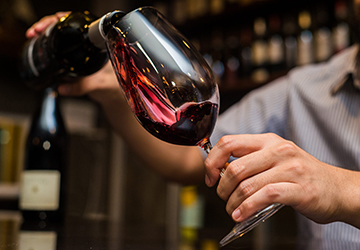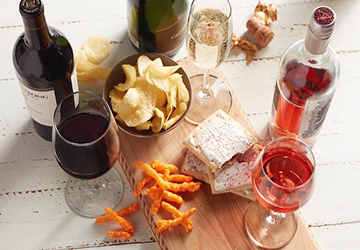Wine pairing is a skill that can elevate your dining experience to new heights, transforming a simple meal into a symphony of flavors. The right combination of wine and food can enhance the taste of both, creating a harmonious balance that tantalizes the palate. In this article, we will explore the art of wine pairing and provide you with the knowledge and tips you need to become a master of this culinary art.

Understanding Wine Characteristics
To master wine pairing, it is crucial to understand the critical characteristics of wine and how they interact with different foods.
• The tartness or sharpness that wine imparts is its acidity.
• The weight and texture of a wine's palate are called its body.
• Tannins are chemical substances present in grapes' skins, seeds, and stems. Tannins provide red wine structure and astringency.
• A wine's sweetness can range from lusciously sweet to bone-dry.
• scents and flavors: Wine has a wide range of scents and flavors, from fruity and flowery to earthy and peppery.
Pairings Of Complementary Foods And Wines
A good dining experience is produced through complementary pairings, which entail matching flavors that complement and improve one another.
· Red meat: Choose bold red wines like Cabernet Sauvignon or Syrah.
· Delicate seafood: opt for crisp whites such as Sauvignon Blanc or Chardonnay.
· Spicy dishes: To cool the palate, try off-dry wines like Gewürztraminer or Riesling.
· Cheese pairing: Pair creamy cheeses with buttery Chardonnay or bold reds with aged cheeses.
· Dessert pairings: Match the sweetness level with Port or Late Harvest Riesling for rich chocolates and Moscato d'Asti or Sauternes for fruity desserts.
Food And Wine Pairings That Differ
It is combining flavors that are opposed to one another or have conflicting characteristics results in a distinctive and engaging dining experience.
· Rich and creamy dishes: Pair with acidic wines like Sauvignon Blanc or Pinot Grigio to cut through the richness.
· Versatile sparkling wine: Pair with appetizers, light seafood, or fried foods for a refreshing contrast.
· Fatty or protein-rich foods: Choose high-tannin red wines like Cabernet Sauvignon or Malbec for balance.
· Sweet and savory contrasts: Pair sweet dessert wines like Late Harvest Riesling with salty or spicy dishes for a unique experience.
Regional Pairing Traditions
Different regions offer perfected pairings: French classics, Italian delights, Spanish tapas, and New World fusion.
· Classic French pairings: Bordeaux with beef, Burgundy with Coq au Vin, Champagne with oysters.
· Italian regional delights: Chianti with pasta, Prosecco with antipasti.
· Spanish tapas and versatile wines: Rioja with tapas, Albariño with seafood.
· New World wines and fusion cuisine: Pairing options abound with wines from the United States, Australia, and South Africa.

Considering Wine Varietals
Different wine varietals possess distinct characteristics, making understanding their attributes and suitable pairings essential.
· Versatile Chardonnay: It goes perfectly well with roasted chicken, seafood, and creamy pasta.
· Bold Cabernet Sauvignon: Perfect for grilled steak, braised short ribs, and aged cheeses.
· Delicate Pinot Noir: Complements roasted salmon, duck, and mushroom-based dishes.
· Refreshing Sauvignon Blanc: Zesty pairing for salads, seafood, and goat cheese.
· Approachable Merlot: Smooth match for roasted poultry, pasta, and vegetarian cuisine.
Experimentation And Personal Preferences
While guidelines and recommendations can be helpful, wine pairing is a personal journey that should reflect your preferences and taste buds.
· Trusting your taste buds: Don't be scared to experiment with new pairings and believe in your taste sensibilities. Because everyone has a different taste, what suits one individual may not do another. Explore and discover your personal preferences.
· Exploring unconventional pairings: Part of the joy of wine pairing is the opportunity to think outside the box and explore strange pairings. Don't be afraid to try unexpected combinations and see how they work together. You may stumble upon a hidden gem of a pairing that surprises and delights you.
· Developing your wine preferences: Wine pairing is a journey of discovery, and part of that journey is developing your wine preferences. Take the time to explore different wines, varietals, and regions. Attend wine tastings, visit vineyards, and talk to sommeliers to expand your knowledge and refine your palate.
Seeking Expert Advice: Sommeliers And Wine Guides
Consult restaurant sommeliers, explore wine guidebooks and online resources, and attend tasting events to enhance wine pairing skills.
· Restaurant sommeliers: Trained professionals with extensive wine knowledge.
· Wine guidebooks and online resources: Access information on regions, varietals, and pairings.
· Wine-tasting events and classes: Learn through hands-on experiences with experts.
The Art Of Presentation: Glassware And Serving Temperatures
The way wine is presented and served can greatly impact the overall experience. Pay attention to glassware and operating temperatures to ensure optimal enjoyment.
· Selecting the proper wine glass
Purchasing quality wine glasses may improve the wine's smells and flavors. Different glass forms are intended to highlight particular wine qualities. Use a big bowl-shaped container for red wines to enable them to breathe while establishing their aromas or a tall, slender flute for sparkling wine to conserve the bubbles.
· Recommended serving temperatures for certain wines
Enjoying wine to its fullest must be served at the proper temperature. Red wines are often served somewhat lower than room temperature, and white wines are typically served chilled. For detailed temperature recommendations for certain varietals, consult wine websites or experts.
Conclusion
Mastering the art of wine pairing is an enjoyable and rewarding journey that allows you to explore the depths of flavor combinations and enhance your dining experiences. You can become a confident wine connoisseur by understanding wine characteristics, exploring complementary and contrasting pairings, considering regional traditions, and trusting your preferences.



